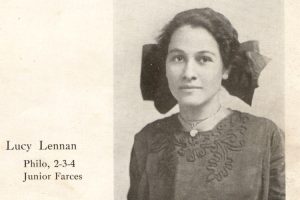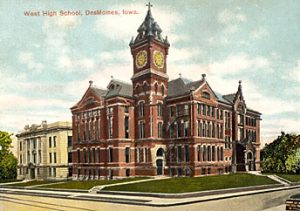West High Tatler Gives Look at High School a Century Ago
Rickety, Rackety, Rickety Rack,
Hullabaloo, Kazoo, Kazack,
Hoo rah, Hoo ray
West Des Moines High School, I-O-A!

Lucy Lennan’s granddaughter, Susan Nelson, donated her old West High yearbooks to the school district, providing a glimpse back into a school more than a century ago.
That’s one of the “yells” that urged the football team of the old West High into gridiron battle, according to the school’s 1910 yearbook. Three copies of “The Tatler” (1909-1911) were recently bequeathed to Des Moines Public Schools by Susan (Hall) Nelson of Windsor, California, whose grandmother, Lucy Lennan (Hall) was a member of the West High Class of 1911.
Here’s some historical context, excerpted from A Brief History of the Des Moines Independent Community School District upon its One Hundredth Anniversary, compiled by Dale Vande Haar, District Library Coordinator, in 2007:
“Because of rapid westward growth in the city, planning began in 1917 to replace West High School at 15th and Center streets with a new high school that would open in 1923 as Theodore Roosevelt High School…”

The spines of the 1909-11 editions of the Tatler, the yearbooks for West High (forerunner of Roosevelt High School).
So West High was the forerunner of Roosevelt. And there in the senior section of the 1911 Tatler is the portrait of Lucy. She looks solemn in a dress that’s plain except for some decorative brocade at the neckline. A trinket dangled from a choker around her neck and her wavy dark hair was held up and back by an oversized bow of the sort that was fashionable among young women of those times. She doesn’t look like someone who would lend herself to the Junior Farces, but she apparently did. She appeared better suited to be a “Philo” or member of the Philomathian Society, a fancy name for Debate Club, and she was that, too.
The books that her granddaughter discovered while sifting through family memorabilia are fragile relics; time capsules brimming with examples of how much times have changed and human nature has remained constant.
They are also some of the earliest remnants of what is now officially known as the Des Moines Independent Community School District. The school district as it exists today didn’t come into being until 1907, when voters approved the consolidation of the East Des Moines and West Des Moines (west side of the city, not the suburb) school districts into one.
The 1909 edition is bound in chamois leather that must have been white upon its publication but has grayed since being retired into storage. Its sections are separated by fine sheets of linen paper. The 1910’s cover was blue velveteen. Of the three, only the 1911 copy was labeled on its spine for easy shelf reference.
The pages of all three teem with attention-getters. Examples: In 1909 the faculty included Nathan Weeks (history teacher) and Albert W. Merrill (math), neither of whom would have guessed at that stage of their careers that Des Moines junior highs/middle schools would one day be named for them.
Speaking of illustrious names, how about Plato Redfern? You’ve probably never heard of him, but he was a BMOC in 1910 when he was named Most Popular Boy, set a state record in the mile run, and was a “yell leader” when he wasn’t running track.
Classwork has evolved. Before there were HDTV and 3D movies, or even the Audiovisual Club to thread reels through projectors, there were stereopticons to liven up stale lectures.
The 1910 Tatler included Halley’s Comet “as photographed by Prof. D.W. Morehouse 3:10 to 3:37 A.M., Friday, May 13, 1910.” Morehouse later established the municipal observatory at Waveland Golf Course and became president of Drake University. “We may all forget the 1910 Tatler Annual but we will always remember Halley’s Comet,” concluded the caption.
Okay, so Plato was the most popular boy in 1910 but who was the “Class Dude”? Roderick Nourse earned that honor “for being able to better spend ‘Dad’s’ money” than the other finalists.
In 1911 the school’s enrollment surpassed 1,000 for the first time and that milestone did not go unnoticed or unremarked upon by Tatler editors.
“This is not a mere matter of local or partisan pride. The graduates of the school are accepted without examinations…and they make good wherever they go, whether to college or to the office or store. The school exerts a leadership in the state and outside of it in many affairs.”
Then, as now, ad sales were critical in underwriting the expenses of publication and there is no better cultural index in any era than advertisement. In the early 20th century there was a lot of local competition to be the preferred haberdasher of young men. Blue serge suits were the wardrobe cornerstone of many a “young chap.”
The Patton-Van Vliet Automobile Company at 10th & Walnut proclaimed: “We invite your inspection of our reliable lines of Automobiles…”
Or this from the early days of a well-known local retailer: “The Charm of Younker Hats…”
The Orpheum Theater downtown promised “the best vaudeville attractions that can be secured in America and Europe. Night prices: 10-25-50 cents. Matinee Daily 25 cents.”
And whatever happened to the Iowa Seed Company greenhouse at 31st & Kingman Boulevard?
Yes, times change but people don’t so much, as witness the following excerpt from “Diary of a Freshman” in 1909:
“They was a lot of girls down in front that kept laffin an squealin but they didn’t look at the game much. Some o’ them girls don’t do nothin but pat they hair and look wize when other girls go past…the coche jist squatted down…and watched the boys the way our old cat does a mouse.”
On the other hand, there was this forecast of the future of senior Elizabeth Chamberlain in 2010: “For years the American women who are eager for the vote have looked upon Miss Lizzie Chamberlain as their avowed leader and staunchest supporter. She has inflamed their fiery hearts with her vehemence and has silenced the caustic tongue of many a scornful son of Adam…”
We don’t know what ever became of Lizzie Chamberlain, West High Class of 1910, but American women did get the right to vote in 1920. If Lizzie were a member of the Class of 2016 she’d probably be enrolled in the Urban Leadership curriculum at Central Campus. That sounds like something that would have interested someone like her.
We do, however, know what came of the original owner of these yearbooks, Lucy Lennan. According to her granddaughter, she married William Hall shortly after graduating from West High and they both were pioneers of a sort, heading to the great northwest of Canada and settling in the town of Sexsmith, Alberta. The couple owned and operated the general store while raising three sons. Lucy and her husband returned to the U.S. in the 1940s, moving to Santa Rosa, California, where they owned a motel until they retired and passed away in the 1960s.
Our thanks to Susan (Hall) Nelson and her grandmother Lucy Lennan (Hall) for providing a peek back in time. Or maybe we should say:
Rickety, Rackety, Rickety Rack,
Hullabaloo, Kazoo, Kazack,
Hoo ray, Hoo rah
Sue and Grand-MA!





